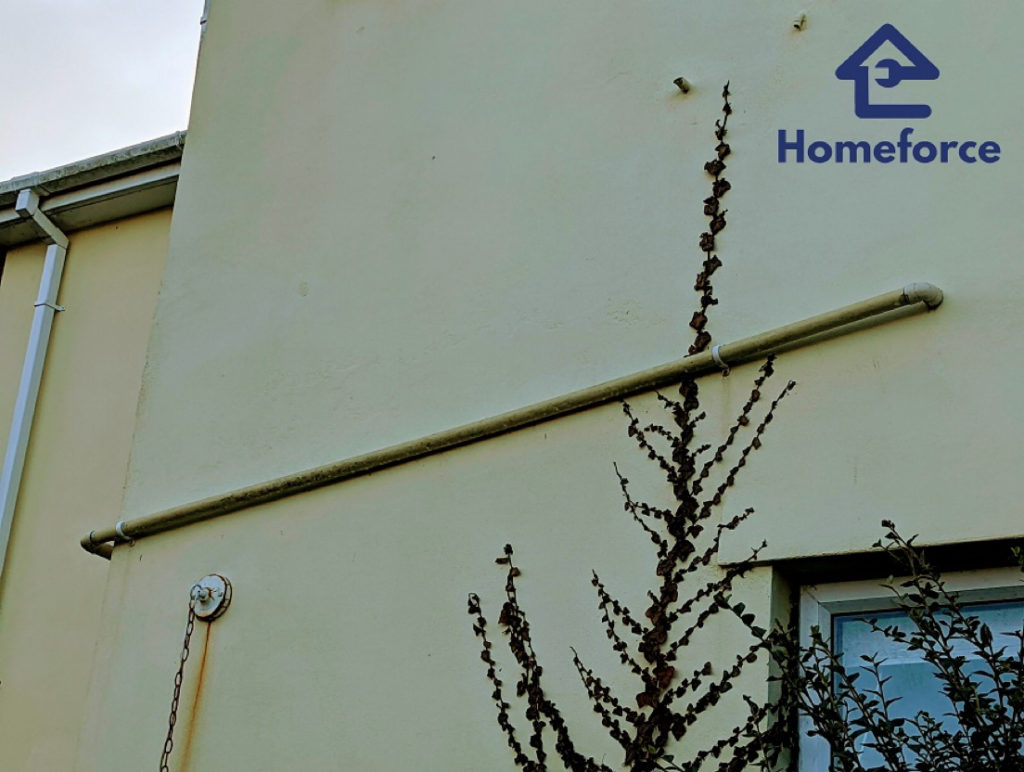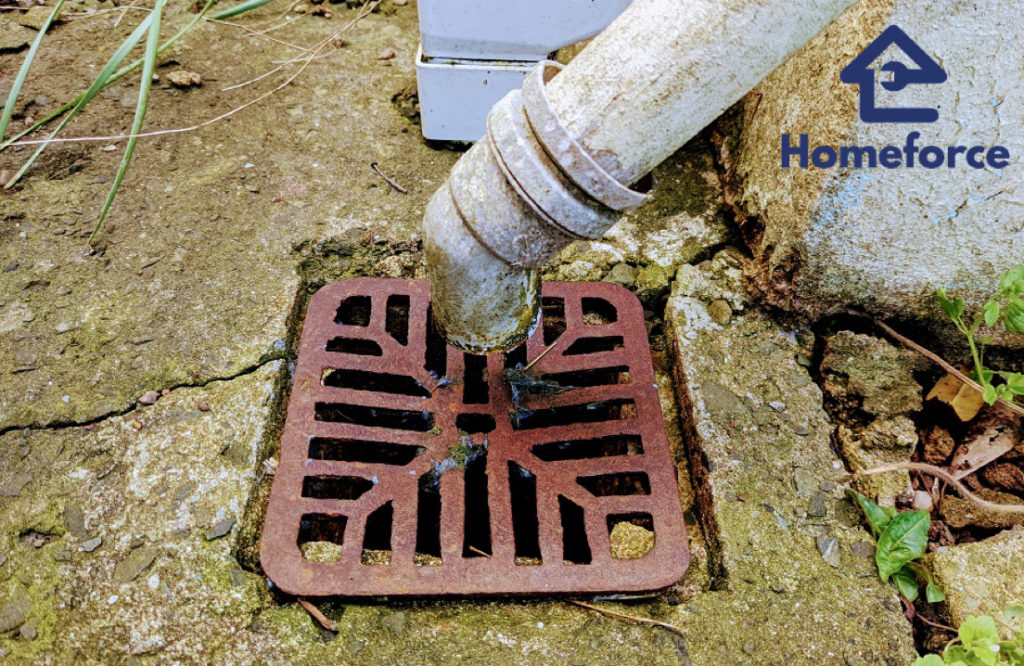Written On
Wed 13th April 2022
Written By
Homeforce
Category
Guides
Share This
Overflowing drains can be a nuisance for many homeowners. It’s not only time consuming to identify the reason and unblock the drain, but it can also lead to a number of other issues.
An overflowing outside drain can cause foul-smelling water, potentially flooding, build-up of bacteria and also structural damage.
Read on to discover everything you need to know about overflowing outside drains.
An outside drain overflowing is the responsibility of the homeowner, the council if in the street, or the landlord if renting. The most likely cause is a blockage either in the pipework or in the drain itself. This can be grease, fat, tree roots, old leaves, hard to flush objects or hair build-up.
With the brief answer in mind, we can get into a few more details of what causes an overflowing outside drain, how to unblock it, and how to prevent it.
So you can understand a little more easily about outside drains overflowing, find out below some of the main causes.
What are the causes of an overflowing drain?
In general, if your outside drain is overflowing, it will most likely be a build-up of debris that’s causing a blockage.
It might be old leaves that have gathered over time or it could even be tree roots that can enter pipes gradually and stop the proper flow of water through the pipework.
An outside overflowing drain can be because of weather conditions such as wind or heavy rain.
Another cause of an outside overflowing drain is generally caused by everyday objects, hair, fat and grease deposits.
You might notice water overflowing from a drain in your garden due to hard to flush objects such as wipes, tissues and paper towels which can cause the pipes to block, causing an overflow.
So whose responsibility is an outside overflowing drain?
Read on to find out more.
Who is responsible for overflowing drains?
All the drains that are within the boundaries of your garden and driveway are your responsibility if you are a homeowner. That includes internal and external drains.
This includes your kitchen drain. If you aren’t sure and think you might share a drain, then your local water or sewage company will know, so you will need to call them to find out.
Overflowing drains and renting
If you rent a home, according to the Landlord and Tenant Act of 1985, it’s your landlord’s responsibility to keep all pipes, drainage and plumbing in good working order.
However if a tenant has caused the blockage by misuse, resulting in overflowing water, the tenant is liable for repairs.
If you notice a blocked drain in the street with water pouring out, your local authority is responsible. They will often have a telephone number on their website where residents can report a flooding or drainage problem.
“All the drains that are within the boundaries of your garden and driveway is your responsibility if you are a homeowner.”

Who is responsible for drain covers?
The drain cover along with the drain is again your responsibility to repair if it is within your home boundary.
Your local water and sewage company is responsible for any lateral drains, along with sewers.
A lateral drain is an underground pipe that carries waste from your home to the sewer. It’s usually under pavement or road, but it might run under your home if you share a sewer.
So if you have noticed an outside drain overflowing, how do you stop it?
How to stop an outside drain from overflowing
There are a few ways to tackle this problem. You can try unblocking the drain by hand to stop the overflowing water, you can try soda crystals to dissolve any grease or build up in the pipes or you can try using a hose.

Stop an outside drain overflowing by hand
Sometimes it’s possible to simply remove a blockage causing an overflow by hand. So before you try any of the other ways, it’s worth seeing if you can remove any debris by hand.
To protect yourself from the flowing water, use bin bags to cover your arms right up to your shoulder. As they can easily tear, layer them up. It’s also an idea to wear a scarf or other face-covering to protect you from any splashes. The water can often be foul-smelling and full of nasties and bacteria. So make sure you are fully protected.
Once you are fully covered and protected, reach into the outside drain and remove any obvious signs of blockage.
Unblocking Drains with Soda Crystals
Using soda crystals can work for removing blockages causing overflowing water if the culprit is fat or grease.
If possible, wait till the water flow has subsided a little before attempting this. It’s worth using a plastic jug or other containers to remove any stale water and try to limit the use of water in your home until it’s been done.
Pour around 60 to 190 grams of soda crystals directly into the overflowing drain. Then to help dissolve the blockage causing the water to flow, follow this step with a kettle full of boiling water.
Caustic soda can be effective but needs to be handled carefully as it can be extremely dangerous. Avoid any contact with skin and eyes and wear protective clothing.

Use a hose or pressure jet for overflowing drains.
Similar to using soda crystals, for this way to work the most successfully, you will need to remove any build-up of stale water from the drain. If you can see any obvious blockages such as leaves or other debris, remove this first by hand, remembering to cover up.
Once the water is at a manageable level, push the hose or pressure jet as far down the drain as possible and seal the entrance to the drain cover.
You can use old towels or other fabrics. If you don’t cover the drain cover, you might find that the drain will continue to overflow once adding more water. Covering the drain will also help to protect you from any splashing of stagnant and foul-smelling water.
The pressure jet or hose will hopefully force out any objects causing the blockage and overflow.
Turn the hose or pressure jet on high for around 10 to 20 seconds. If it hasn’t worked after this time, then it’s likely that you will need to call a plumbing and drainage professional.
What can I do if I can’t fix an overflowing drain myself?
If you have tried some of the solutions above and you are still having drain overflowing issues it might be time to call in a professional.
Qualified plumbers can be at your home dealing with plumbing and drainage issues swiftly and will also have all the right tools and knowledge to safely remove any blockages causing overflowing water.
They will also be able to give you expert advice for keeping drains in the best condition.
Can I buy cover for drainage systems and other plumbing?
Anyone who’s experienced drainage problems understands that it can come with added costs that you haven’t budgeted for.
Emergency call out charges can add up for homeowners and even if you are careful to make sure you are responsible when it comes to your plumbing system, sometimes an overflowing drain can cause issues you haven’t prepared for.
Here at Homeforce, we offer plumbing and drainage plans with no hidden costs. A nationwide team of experts are on hand to help you with any overflowing water problems. Click here for more information and a quote.